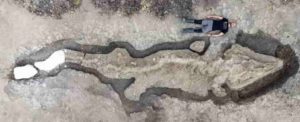
A gigantic prehistoric “sea dragon” discovered in the Midlands has been described as one of the greatest finds in the history of British palaeontology.
The fossil, identified as an ichthyosaur, an ancient marine reptile that swam in Earth’s prehistoric oceans when dinosaurs walked on land, was found poking out of the mud, and scientists say the ancient specimen is practically complete from tip to tail.
The ichthyosaur, which is about 180m years old with a skeleton measuring about 10 metres in length and a skull weighing about a tonne, is the largest and most complete fossil of its kind ever found in the UK. Joe Davis of the Leicestershire and Rutland Wildlife Trust discovered it during the routine draining of a lagoon island at the Rutland Water reservoir in February 2021.
The first ichthyosaurs, which are called sea dragons because they tend to have very large teeth and eyes, were discovered by the fossil hunter and palaeontologist Mary Anning in the early 19th century.
Ichthyosaurs, which were marine reptiles, first appeared about 250m years ago and went extinct 90m years ago. They varied in size from 1 to more than 25 metres in length and resembled dolphins in their general body shape.
The remains were dug out by a team of experts from around the UK in August and September.
“Our specimen, the Rutland Ichthyosaur or the Rutland Sea Dragon, is the biggest complete ichthyosaur ever found in Britain in over 200 years of collecting these things scientifically,” says paleontologist Dean Lomax who led the excavation.
Two incomplete and much smaller ichthyosaurs were found during the construction of Rutland Water in the 1970s, but the latest discovery is the first complete skeleton.
The spectacular specimen, only recently revealed to the public, is still wrapped in its plaster cast, stored in a secret location, and has not yet been studied in detail. The researchers plan to prepare academic papers describing the discovery once it has been cleaned up and conserved.










